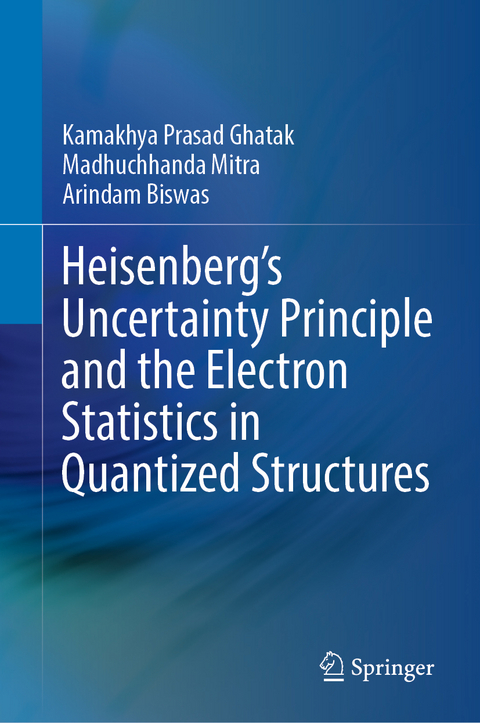
Heisenberg’s Uncertainty Principle and the Electron Statistics in Quantized Structures
Springer Verlag, Singapore
978-981-16-9843-9 (ISBN)
Prof. Dr. Engg. Kamakhya Prasad Ghatak of IEM, Kolkata obtained his PhD Degree from the Institute of Radio Physics and Electronics of the Calcutta University in 1988 on the basis of 27 research papers in reputed SCI Journals which is still a record of the said Institute. He is the first Doctor of Engineering Degree awardee of Jadavpur University in 1991(h-index-35, i-10 index- 181& T.C.-5746, the author of 370 SCOPUS publications, 17 books on Nano Technology) and as per World Ranking of top 2% Scientists as prepared by Stanford University, USA, in 2020, he stays within top 1% in the field of Applied Physics. From the position of Assistant Professor in Calcutta University in 1983 up to Senior Professor in the Institute of Engineering and Management, Kolkata in 2015 he was at the top of the merit lists in all the cases. His score in Vidwan portal unit of Government of India is 8.7 out of 10, the highest score among the private Engineering Universities and Institutions of West Bengal. He has produced more than 50 PhD students and the list includes Director, Vice Chancellor, Professors and CEO’s of different Private organization. Dr. Madhuchhanda Mitra received her Ph.D. from the University of Calcutta, India. She is a recipient of “Griffith Memorial Award” of the University of Calcutta. Her present research interests are nano-science and technology, identification of different biomarkers and biomedical signal processing which includes feature extraction, compression, encryption and classification of electrocardiography (ECG) and photoplethysmography (PPG) signals. At present, she is a professor in the Department of Applied Physics, University of Calcutta, India, where she has been actively engaged in both teaching and research in Instrumentation. Dr. Arindam Biswas received his M.Tech. in Radio Physics and Electronics from the University of Calcutta, India, in 2010, and Ph.D. from NIT Durgapur, in 2013. He was a postdoctoral researcher at Pusan National University, South Korea, under the prestigious BK21PLUS Fellowship. He was a visiting professor at Research Institute of Electronics, Shizuoka University, Japan. Currently, Dr. Biswas is working as an assistant professor in the School of Mines and Metallurgy, Kazi Nazrul University, Asansol, West Bengal, India. His research interests are in the area of carrier transport in low-dimensional systems and electronic devices, nonlinear optical communications, and THz semiconductor sources.
1. Introduction.- 2. The HUP and the ES in HD Kane Type III-V and Opto-Electronic Materials Under Intense Electric Field.- 3. The HUP and the ES in Quantum Wells (QWs) of HD Non-Parabolic Materials.- 4. The HUP and the ES in Nano Wires of HD Non-Parabolic Materials.- 5. The HUP and the ES in Quantum Dots (QDs) of HD Non-Parabolic Materials.- 6. The HUP and the ES in doping super lattices of HD Non-Parabolic Semiconductors.- 7. The HUP and the ES in Accumulation Layers of Non-Parabolic Semiconductors.- 8. The HUP and the ES in Heavily Doped (HD) Non-Parabolic Semiconductors under Magnetic quantization.
| Erscheinungsdatum | 06.04.2022 |
|---|---|
| Zusatzinfo | 63 Illustrations, color; 70 Illustrations, black and white; XXVI, 234 p. 133 illus., 63 illus. in color. |
| Verlagsort | Singapore |
| Sprache | englisch |
| Maße | 155 x 235 mm |
| Themenwelt | Naturwissenschaften ► Chemie |
| Naturwissenschaften ► Physik / Astronomie ► Atom- / Kern- / Molekularphysik | |
| Naturwissenschaften ► Physik / Astronomie ► Festkörperphysik | |
| Naturwissenschaften ► Physik / Astronomie ► Quantenphysik | |
| Naturwissenschaften ► Physik / Astronomie ► Thermodynamik | |
| Schlagworte | Acoustic Mode Scattering • Debye Screening Length • Graded Interfaces • Hall Effect • Heavily Doped (HD) semiconductors • Intense Light Waves • Inversion Layers • Kane Type III-V Structures • magnetic susceptibilities • Magneto-Thermal Effect • Non-Parabolic Materials • Quantized Magnetic Fields • Quantized Structures • Quantum Dot Heavily Doped Superlattices (QDHDSLs • Quantum-Wires • Quaternary Semiconductors • Raman Gain • Super Lattices • thermoelectric power • ultrathin films |
| ISBN-10 | 981-16-9843-0 / 9811698430 |
| ISBN-13 | 978-981-16-9843-9 / 9789811698439 |
| Zustand | Neuware |
| Informationen gemäß Produktsicherheitsverordnung (GPSR) | |
| Haben Sie eine Frage zum Produkt? |
aus dem Bereich


